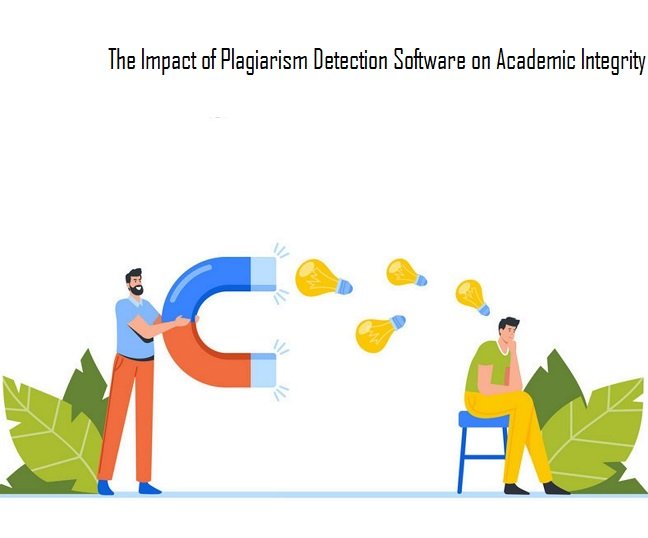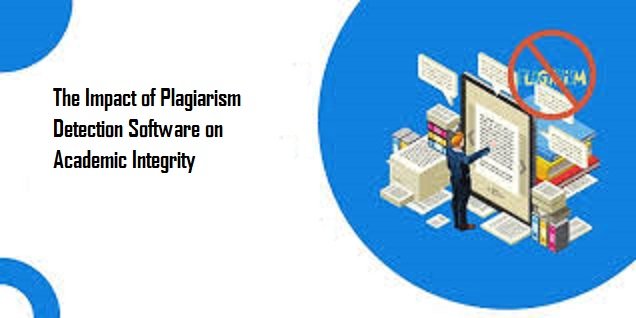- June 12, 2024
- Posted by: Igbaji Chinwendu
- Category: Project Writing Guide

The Impact of Plagiarism Detection Software on Academic Integrity
Introduction
Plagiarism continues to constitute serious challenges in academic circles. In academic assignments, plagiarism is defined as using someone else’s words, ideas, or works without giving due credit. It is a grave academic and ethical transgression with potentially dire repercussions.
Self-plagiarism is the practice of reproducing one’s own previously published work without providing correct attribution. Other examples of plagiarism include paraphrasing without citing the original author and copying and pasting information from sources.
Plagiarism not only compromises academic integrity but also calls into question the values of impartiality, honesty, and deference to the work of others. It is imperative that people follow moral principles in their academic endeavours and give credit where credit is due.

Types of Plagiarism
- Direct Plagiarism: This is when someone takes an exact quote verbatim from a source without giving credit.
- Mosaic plagiarism: in this kind, sentences and paragraphs are taken verbatim from a source and pieced together without giving due credit.
- Self-plagiarism: This is reusing one’s own work without giving due credit
- Accidental Plagiarism: Inadvertently failing to properly credit sources.
- Collaborative Plagiarism: This kind of plagiarism happens when two or more students work together on a project and then turn in the completed product without giving due credit.
- Paraphrasing Plagiarism: This kind of plagiarism happens when a student summarises another author’s thoughts without giving due credit. When a student paraphrases, they do it in their own words while omitting to acknowledge the original originator of the ideas.
Consequences of Plagiarism
Plagiarism in academic assignments can have serious repercussions, which could include:
- Academic Penalties: If plagiarism is found in an assignment or course, students risk receiving failing grades.
- Damage to Reputation: A person’s credibility and reputation can be damaged by plagiarism.
- Legal Repercussions: If plagiarism involves copyright infringement, there may be legal repercussions.
- Professional Consequences: Plagiarism has the potential to cost academics and professionals their jobs or their professional status.
Prevention of Plagiarism
All sources—including books, journals, websites, and interviews—used in academic work must be correctly cited to prevent plagiarism. Proper citation styles, such as MLA, APA, and Chicago, should be used to guarantee accuracy and consistency.
Students should provide in-text citations and enclose direct quotes in quotation marks to further emphasise the source of the information. Various steps can be taken by individuals and educational institutions to stop plagiarism.
These actions include:
- Awareness efforts aimed at teaching researchers and students the value of accurate referencing and citation.
- Adopting the use of Plagiarism Detection software by educational institutions to find possible plagiarism in assignments that are turned in.
- Emphasizing stated guidelines that outline expectations for academic integrity and citation styles in a clear and concise manner.
- Promoting original work, original thought and in-depth research.
Functions and operations of plagiarism detection software
Plagiarism detection software is made to find instances of plagiarism in documents. These instruments are employed to maintain academic and professional integrity and guarantee the uniqueness of the content.
Text comparison, database scanning, and report production are just a few of the important features that plagiarism detection software offers.
- Text Comparison: Comparing the provided text with a sizable database of previously published information is one of the main purposes of plagiarism detection software. In order to find parallels with other sources, this comparison entails dissecting the text’s general content, language, and structural elements. This comprehensive comparison is carried out using sophisticated algorithms that include multiple language and environmental factors.
- Database Scanning: Online publications, scholarly journals, websites, and proprietary databases are just a few of the many sources that plagiarism detection software searches through. The software can cross-reference the given content with a large body of previously published material thanks to this thorough approach. Through the utilisation of several information sources, the software is able to identify possible cases of plagiarism with accuracy.
- Report Generation: After the analysis is finished, plagiarism detection software produces a comprehensive report that lists all instances of plagiarism that were found. Usually, this report draws attention to particular text passages or sections that correspond with available sources. It might also reveal information about the degree of similarity found and make suggestions for additional investigation or action.
- Integration with Learning Management Systems (LMS): A lot of academic institutions use plagiarism detection software that works well with their LMSs. This integration allows effective communication between teachers and students regarding plagiarism issues and expedites the process of submitting assignments for analysis.
- Educational Resources: Certain software solutions not only detect plagiarism but also include educational materials to raise awareness and foster comprehension of academic integrity. These materials could include standards for correct citation and attribution, best practices, and tutorials.
Impact of plagiarism detection software on academic integrity
|
Positive Impact |
Negative Impact |
|
Students who might be inclined to commit academic dishonesty are discouraged from doing so by the use of plagiarism detection tools. Students who are aware that their work will be carefully examined for originality are more inclined to maintain academic integrity and turn in original work. |
Some educational institutions or instructors risk relying too heavily on plagiarism detection technologies as the only means of combating academic dishonesty. This can result in less emphasis being placed on teaching appropriate research and citation techniques. |
|
These computer programs also function as teaching aids, assisting learners in comprehending the significance of referencing references and generating unique content. By identifying instances of plagiarism, students can learn how to correctly attribute content and avoid inadvertent plagiarism. |
Occasionally, plagiarism detection technologies may produce false positives, labelling original information as copied when in fact it is not. This may put teachers and students under needless stress and give rise to disagreements regarding the veracity of the software’s conclusions. |
|
Upholding Standards: By guaranteeing that submitted work satisfies the criteria of originality and appropriate citation, plagiarism detection software assists institutions in upholding academic standards. This helps to preserve the general calibre and legitimacy of scholarly writing and research. |
Some students may try to get around plagiarism detection software by adopting clever strategies to avoid being found out, like paraphrasing or gaining access to outside sources that the software hasn’t indexed. |
Conclusion
Plagiarism reduces the value of education, erodes the originality and integrity of scholarly research, and can have major repercussions for those who engage in it. Academic integrity has been significantly impacted by plagiarism detection technologies. These instruments are intended to detect instances of plagiarism in written assignments such as research papers, essays, and other academic works.
